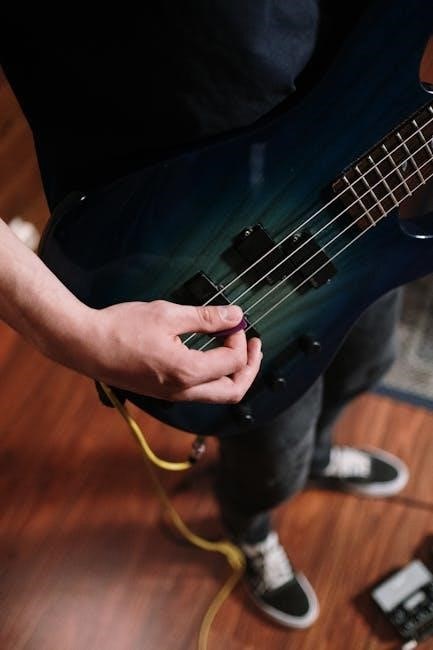Fretboard Notes PDF: A Comprehensive Guide
Welcome to the ultimate guide to guitar fretboard mastery! This resource will equip you with printable PDF diagrams, essential knowledge, and strategies for learning the fretboard. Get ready to unlock your guitar playing potential!
Fretboard diagrams are visual representations of a guitar’s neck, showing the position of notes across the strings and frets. These diagrams serve as invaluable tools for guitarists of all levels, aiding in learning scales, chords, and arpeggios. They provide a clear map of the fretboard, eliminating guesswork and fostering a deeper understanding of the instrument’s layout.
Whether you’re a beginner struggling to find your way around the neck or an experienced player seeking to expand your knowledge, fretboard diagrams can significantly accelerate your progress. By visually representing the notes, these diagrams facilitate memorization and enable you to create your own custom charts for chords and scales.

Understanding Fretboard Basics
Before diving into diagrams, grasp the fundamentals of the guitar fretboard. Learn about string names, fret numbering, and how notes are arranged to build a solid foundation for future learning and exploration.
Standard Tuning and Note Placement
Standard guitar tuning (EADGBE) is the foundation. Each string, when played open, produces a specific note. As you move up the fretboard, each fret represents a half-step increase in pitch. Understanding this sequential note placement is key. For instance, the first fret on the E string is F, then F#, and so on. Knowing the notes on the low E and A strings is a great starting point for mapping out the entire fretboard. Visualize the chromatic scale along each string to internalize the note relationships; Focus on memorizing the natural notes first.
Free Printable Fretboard Diagrams
Access our collection of free, printable fretboard diagrams in PDF format. These resources are designed to aid guitarists of all levels in visualizing and learning the fretboard notes.
Blank Fretboard Diagrams for Customization
Unleash your creativity with our blank fretboard diagrams! These PDFs offer a clean slate for you to map out chords, scales, and personalized learning tools. Use them to create your unique exercises, visualize patterns, and challenge yourself with note and interval memorization. These are designed with light lines, guaranteeing that your markings will be clearly visible. Download and print these blank diagrams to create custom guitar resources that cater to your specific learning needs. Whether you’re exploring new tunings or creating visual aids for complex musical concepts, these diagrams are your canvas for fretboard mastery.
Labeled Fretboard Diagrams for Beginners
Embark on your fretboard journey with our labeled diagrams designed specifically for beginners! These user-friendly PDFs clearly display all the notes on the guitar neck, providing a visual roadmap for learning. Start memorizing note positions, understanding the relationships between notes, and building a solid foundation for chord and scale construction. These diagrams are excellent resources to familiarize yourself with the guitar neck notes. With clear labeling and easy-to-read formats, these diagrams will accelerate your learning process and empower you to navigate the fretboard with confidence. Unlock your musical potential today with these indispensable learning aids!

Using Fretboard Diagrams for Learning
Fretboard diagrams are invaluable tools for guitarists. They aid in memorizing notes, creating chord charts, and understanding scales. Utilize them to visualize musical concepts and enhance your overall learning experience.
Memorizing Notes on the Fretboard
Memorizing the notes on the guitar fretboard is crucial for any guitarist. Start by focusing on one string at a time, learning the natural notes (A, B, C, D, E, F, G) first. Use fretboard diagrams to visually reinforce your learning. Practice naming the notes out loud as you play them. Break the fretboard into smaller, manageable sections, such as the first five frets.
Regularly quiz yourself to reinforce your memory. Connect the notes to familiar songs or melodies. Utilize mnemonic devices or patterns to aid recall. With consistent practice and focused effort, fretboard mastery is within reach, unlocking greater musical freedom.
Creating Chord and Scale Charts
Crafting personalized chord and scale charts is invaluable for guitarists. Begin with blank fretboard diagrams, readily available online in PDF format. Mark the root note of the chord or scale as a starting point. Use different colors or symbols to differentiate between notes.
For chords, indicate the fingerings you find most comfortable. For scales, map out the intervallic pattern across the fretboard. Experiment with various positions and voicings. Regularly practice playing the chords and scales from your charts. This hands-on approach reinforces learning and fosters a deeper understanding of music theory. Custom charts offer a tailored learning experience.
Advanced Fretboard Concepts
Delve into sharps, flats, and alternate tunings; Explore beyond standard positions to unlock new sonic possibilities. Master these advanced concepts using fretboard diagrams and expand your musical horizons significantly.
Understanding Sharps and Flats
Sharps (#) and flats (♭) represent notes that are a half-step higher or lower than natural notes. Understanding their placement on the fretboard is crucial for playing in different keys and navigating complex chord progressions. A sharp raises a note by a semitone, while a flat lowers it by the same amount. Visualizing these alterations on your fretboard diagrams will significantly improve your ability to play scales, chords, and melodies in any key. Master the relationship between sharps, flats, and natural notes to unlock the full potential of the guitar fretboard and enhance your musical expression. Practice identifying and playing these notes across the neck.
Exploring Different Tunings
Beyond standard tuning (EADGBE), numerous alternate tunings offer unique sonic landscapes and facilitate different playing styles. Drop D (DADGBE), for example, allows for powerful bass lines and easier power chords. Open tunings, like Open G (DGDGBD), are popular in blues and slide guitar. Each tuning changes the fretboard layout, necessitating a new understanding of note positions. Using fretboard diagrams specific to each tuning is essential for navigating these altered landscapes. Experimenting with different tunings can inspire new musical ideas and expand your creative horizons, but remember to adapt your knowledge of sharps, flats, and natural notes accordingly. Dive into the world of alternate tunings and discover fresh possibilities.

Resources for Fretboard Mastery
Elevate your fretboard knowledge with online generators, which create custom diagrams for tunings. Explore software like Guitar Pro. These resources offer tailored learning experiences for guitarists of all skill levels.
Online Fretboard Diagram Generators
Unlock the power of customization with online fretboard diagram generators, your key to visualizing the guitar neck in countless ways. These tools let you create charts tailored to specific tunings, string configurations, and even the number of frets on your instrument.
Whether you’re exploring alternate tunings or focusing on a particular section of the neck, these generators provide a dynamic learning experience. Print your custom diagrams for easy reference, or use them interactively on your device.
Experiment with different layouts, highlight specific notes or intervals, and create personalized learning aids that cater to your individual needs. With online fretboard diagram generators, mastering the guitar neck has never been more accessible or engaging.
Guitar Pro and Similar Software
Elevate your guitar learning with Guitar Pro and similar software, powerful tools that go beyond static fretboard diagrams. These programs offer interactive fretboard displays, allowing you to visualize scales, chords, and arpeggios in real-time.
Create custom exercises, transcribe songs, and explore different musical ideas with ease. Guitar Pro also provides features like playback, looping, and tempo control, making it an invaluable asset for practicing and refining your skills.
Furthermore, these programs often include vast libraries of guitar tabs and lessons, expanding your repertoire and knowledge. Embrace the digital age and unlock a new dimension of guitar learning with Guitar Pro and its counterparts.

Benefits of Using Fretboard PDFs
Fretboard PDFs offer a visual and portable way to learn the guitar neck. They aid memorization, allow for creating custom charts, and provide accessible learning anytime, anywhere. Embrace the power of visual learning!
Visual Learning and Memorization Aid
Using fretboard PDFs greatly enhances visual learning by presenting the guitar’s neck in a clear, easy-to-understand format. The visual representation of notes, chords, and scales on the fretboard allows guitarists to quickly grasp the spatial relationships between them. This method is particularly beneficial for beginners, as it provides a roadmap to navigate the instrument.
Moreover, fretboard diagrams significantly aid memorization. By repeatedly referring to these diagrams, guitarists can commit the location of notes to memory more effectively. The visual cues provided by the PDFs create stronger neural pathways, making it easier to recall information and improve fretboard fluency. Regular practice with these aids transforms abstract musical concepts into concrete, visual patterns, accelerating the learning process.
Portable and Accessible Learning Tool
Fretboard PDFs offer unparalleled portability, allowing guitarists to learn and practice anywhere, anytime. Unlike physical books or online resources that require internet access, a downloaded PDF can be accessed on any device, even offline. This makes it an ideal tool for musicians on the go, whether traveling, commuting, or simply practicing in a location without Wi-Fi.
The accessibility of fretboard PDFs extends to their ease of use. They can be quickly printed for hands-on study or viewed on a tablet or smartphone. This versatility ensures that guitarists can seamlessly integrate fretboard diagrams into their practice routine, regardless of their environment or available resources. The convenience and accessibility of these PDFs make them an invaluable asset for any aspiring guitarist.